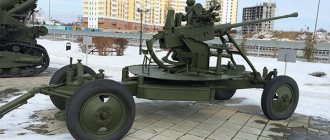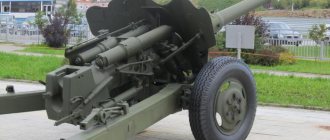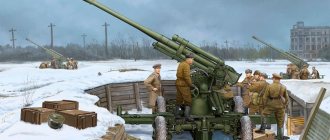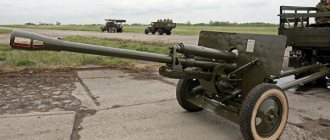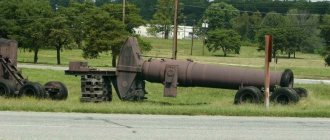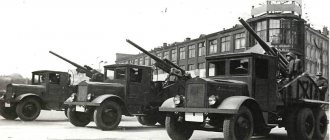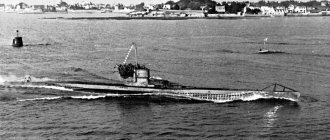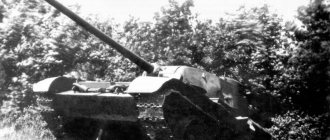Home » Alternative tank building » Anti-aircraft 100 mm gun KS-13 (USSR) and a possible AI self-propelled gun with this gun.
Alternative tank building
boroda 03/07/2020 3170
18
in Favoritesin Favoritesfrom Favorites 9
In the article - Self-propelled universal artillery mount (SUAU) for the RF Armed Forces 2012
, colleague Cosmonaut Dmitry, mentioned the wonderful Soviet anti-aircraft artillery mount KS-19. I think this is a great opportunity to learn more about this gun.
Modernization of the KS-19M gun
By decision of the Ministry of Armaments and the Main Artillery Directorate, Plant No. 8 in 1950 modernized the 100-mm anti-aircraft gun mod.
1947 in order to improve its combat and experimental characteristics. Changes in the system:
The monoblock has widened (strengthened) fields. The field width is 3.15 mm instead of 2.55 mm for standard guns.
In the period January-June 1951, field tests of the KS-19M were carried out at NIAP.
The KS-19M passed field tests in the amount of 520 rounds (216 of them with a reinforced charge), carried 1,500 km behind a Studebaker along a gravel highway.
Rapid fire shooting was carried out at a rate of 1416 rounds per hour.
The KZU-16MU carriage was tested by firing 520 rounds (216 with a reinforced charge) and traveling 1,500 km. 172 shots with an amplified charge were fired from a concrete platform at an angle of 70 with the firing direction along the main beam between the supports and along the folding stop.
The cart as a whole did not withstand the test.
A barrel with reinforced fields when firing within 520 shots ensures normal projectile guidance along the channel. There were no punctures or creases in the fields. However, due to the insufficient number of shots fired, NIAP did not determine the advantages of reinforced fields compared to standard fields.
Platform upgrades
In 1947, at Plant No. 8, a preliminary design of a self-propelled platform for the 100-mm KS-19 (KS-32) gun was developed.
During the operation of the KZU-16 (52-U-415) platform, a number of shortcomings were identified, the elimination of which by upgrading the platform turned out to be impossible. Therefore, in 1953, Plant No. 13 was tasked with developing a new vehicle to replace the KZU-16. In the new cart, it was planned to replace the manual drive for transferring from the stowed position and back (time no more than 5 minutes), eliminate overloading of the wheels (especially the rear ones), increase the speed on the highway to 40 km/h, increase the stability of the gun (the maximum tilting angle of the cart with a gun in statics 38), etc.
In 1954, Plant No. 13 presented a technical design for the KZU-26 platform, chief designer I. I. Plotnikov. However, this technical design was rejected by the Ministry of Defense Industry and the State Agrarian University,
At the beginning of January 1955, the GAU presented the technical design of the new KZU-28 platform of plant No. 13. On February 19, 1955, the technical design was approved with minor comments and it was decided to produce a prototype.
The data is given for the operation of two replaceable jacks.
A prototype of the KZU-28 platform, No. 111, passed field tests in the amount of 1,667 rounds and a haul of 2,000 km. According to the commission’s conclusion: the platform passed field tests. The KZU-28 has a number of advantages over the KZU-16, which significantly improve the performance properties of the KS-19M2 gun and should be recommended for production instead of the KZU-16.
Due to the significant excess weight of the KZU-28 compared to the KZU-16, it is necessary to submit a report to the Minister of Defense with a view to obtaining consent to increase the weight of the KS-19M2 platform due to the introduction of the KZU-28 platform.
Production of KS-19
History of creation
In November 1947, a prototype KS-19 on a ZU-17 cart was tested by shooting and carriage at NIZAP. After some changes were made to ZU-17, it was given the index KZU-16.
An experimental series of four KS-19s was manufactured at Plant No. 8 in September 1947 and passed factory tests in the same month. The KZU-16 carriage was developed at Plant No. 13. In December 1947, the battery passed military tests in the amount of 3,653 rounds and 1,506 km of run (one system was tested). Minor defects were noted in KZU-16. Based on the results of military tests, the KS-19 was recommended for adoption.
For service with the Soviet Army, a 100-mm cannon mod. 1947 (KS -19) was adopted by resolution of the Council of Ministers No. 2886-1184 of March 2, 1948 and by order of the Ministry of Defense Industry of March 22, 1948.
In 1948, Plant No. 8 rebuilt the experimental battery after military tests, handed it over to the customer, and on September 1, 1948, the battery was sent to NIZAP.
Notes
- International Institute for Strategic Studies.
The Military Balance 2016 / James Hackett. - London: Taylor&Francis, 2016. - P. 320. - 504 p. — ISBN ISBN 9781857438352. - International Institute for Strategic Studies.
The Military Balance 2016 / James Hackett. - London: Taylor&Francis, 2016. - P. 82. - 504 p. — ISBN ISBN 9781857438352. - International Institute for Strategic Studies.
The Military Balance 2016 / James Hackett. - London: Taylor&Francis, 2016. - P. 449. - 504 p. — ISBN ISBN 9781857438352. - International Institute for Strategic Studies.
The Military Balance 2016 / James Hackett. - London: Taylor&Francis, 2016. - P. 326. - 504 p. — ISBN ISBN 9781857438352. - International Institute for Strategic Studies.
The Military Balance 2016 / James Hackett. - London: Taylor&Francis, 2016. - P. 242. - 504 p. — ISBN ISBN 9781857438352. - International Institute for Strategic Studies.
The Military Balance 2016 / James Hackett. - London: Taylor&Francis, 2016. - P. 438. - 504 p. — ISBN ISBN 9781857438352. - The Military Balance 2022. - P. 455.
- International Institute for Strategic Studies.
The Military Balance 2016 / James Hackett. - London: Taylor&Francis, 2016. - P. 265. - 504 p. — ISBN ISBN 9781857438352. - International Institute for Strategic Studies.
The Military Balance 2016 / James Hackett. - London: Taylor&Francis, 2016. - P. 393. - 504 p. — ISBN ISBN 9781857438352. - International Institute for Strategic Studies.
The Military Balance 2016 / James Hackett. - London: Taylor&Francis, 2016. - P. 344. - 504 p. — ISBN ISBN 9781857438352. - International Institute for Strategic Studies.
The Military Balance 2016 / James Hackett. - London: Taylor&Francis, 2016. - P. 345. - 504 p. — ISBN ISBN 9781857438352. - International Institute for Strategic Studies.
The Military Balance 2016 / James Hackett. - London: Taylor&Francis, 2016. - P. 354. - 504 p. — ISBN ISBN 9781857438352. - The Military Balance 2007. - P. 312.
- The Military Balance 2007. - P. 196.
- V. Ilyin.
Attack aircraft and fighter-bombers. — P. 70. - A. Khaustov, A. Kotlobovsky.
European style tornado. — P. 19.
Background to the development of the weapon
At the end of the 20s, the leadership of the USSR decided to concentrate the production of all small and medium-caliber anti-aircraft guns for the army and navy at plant No. 8. This included 37-mm anti-aircraft guns. The plant's capacity and its engineering staff left much to be desired.
The plant had never made automatic weapons before. The result was immediate: not only the production of 37-mm anti-aircraft machine guns mod. 1928, but also all other types. Among them were anti-aircraft guns 2-K (20 mm) and 4-K (37 mm), the manufacturing documentation and prototypes of which were transferred in 1930 by the German company Rheinmetall.
Over the three years of operation, Plant No. 8 produced only 75 2-K and six 4-K assault rifles, but none of them were completed. As a result, the armed forces of the USSR until 1940 were left without high-speed anti-aircraft guns.
Installation drawing
Development of the weapon, adoption and serial production
The need for powerful anti-aircraft artillery guns capable of fighting heavy bombers flying at high altitudes arose immediately after the end of World War II. The presence of 85-mm cannons as part of the country's air defense system could not provide reliable protection for army units, military and civilian infrastructure facilities from air raids of a potential enemy.
The response to threats from Western countries was the creation in the USSR of a new powerful anti-aircraft artillery system KS-19, capable of calling into question the dominance of enemy bombers. The main developer of the new gun was the design bureau under the leadership of D.V. Lyuleva. It was this team that managed to create a completely new weapon in 1947. The very next year, the 100-mm KS-19 anti-aircraft gun of the 1947 model was put into service.
The gun was manufactured at factory No. 235. Between 1948 and 1956, Soviet industry provided the Armed Forces with more than 10 thousand guns of this system.
Operation history
In the absence of other anti-aircraft guns, 21-K guns were installed on all classes of ships of the Soviet fleet - from patrol boats and submarines to cruisers and battleships. Re-equipment of auxiliary vessels used for transporting weapons and ammunition with 45-mm AU 21-K made it possible to halve the losses of these vessels in the Northern Fleet.
The installation of 21-KM with increased weight reduced the already low metacentric height of the boats. The shields themselves, due to their large area, increased windage, and during a storm the waves tended to tear the cannon off the deck, so they were soon abandoned on small ships.
In the post-war period, 21-K was installed on the barrels of the main caliber guns of cruisers to perform firing training and save the life of more expensive heavy guns.
21-KM guns are still used on ships of the Russian Navy as salute guns.
General information
KS-19 ensured combat against air targets with speeds of up to 1200 km/h and altitudes of up to 15 km. All elements of the complex at the combat position are connected to each other by electrical wires.
The gun is aimed at the lead point by a hydraulic power drive GSP-100 from PUAZO. But manual guidance is possible.
The KS-19 cannon is mechanized:
installation of a fuse;
chambering the cartridge;
closing the shutter;
firing a shot;
opening the bolt and extracting the cartridge case.
Preparation of the next shot begins with pressing the trigger handle of the automatic fuse installation.
Firing modes:
13 shots in 1 minute;
45 shots in 5 minutes;
110 shots in 60 minutes;
160 shots in 120 minutes.
Firing at the next target is possible in no less than 2.5 minutes.
The GSP-100M system is designed for automatic remote guidance in azimuth and elevation angle of eight or fewer KS-19M2 guns and automatic input into the ACF of values for setting the fuse according to PUAZO data.
The GSP-100M system provides the possibility of manual guidance on all three channels using indicator synchronous transmission. The GSP-100M system includes GSP-100M gun sets (according to the number of guns), a central distribution box (CDB), a set of connecting cables and a battery supply device.
The source of power supply for GSP-100M is a standard power station SPO-30, which generates three-phase current with a voltage of 23-133 V and a frequency of 50 Hz.
All guns, SPO-30 and PUAZO are located within a radius of no more than 75 m (100 m) from the CRY.
System design
The gun barrel consists of a pipe, breech, coupling, lining with basting, muzzle brake and nut.
Semi-automatic vertical wedge shutter.
The cradle is cast, in front it has a holder with three holes: one for the rollback brake cylinder, two for the rollback brake cylinders.
The mechanism for changing the rollback length is assembled on the right side of the cradle.
The tray is designed to hold the cartridge during installation of the fuse, to feed the cartridge into the loading line, and to guide it during loading. The tray is assembled on a bracket welded to the left wall of the cradle.
The rammer is hydropneumatic, with a hydraulic accelerator. Before the first shot, the rammer is cocked manually using a winch, then ramming is carried out using recoil energy.
The lifting mechanism has one gear sector mounted on the cradle. The lifting mechanism operates hydraulically and manually.
The turning mechanism includes a main gear engaged with a ring gear.
The balancing mechanism is spring-type, pulling, and has two columns.
The machine is a welded structure consisting of a cast base, right and left cheeks, reinforced with a stiffener, front and rear connections.
The KZU-16 platform is four-axle, with torsion bar suspension. Trolleybus-type wheels with GK tires,
The platform consists of: a frame with two stops, forward and reverse gears, two compensators (mechanisms to facilitate transfer from the traveling to the combat position and back) and smaller components.
The frame is a cross-shaped welded beam of box-section, with two side brackets for attaching folding stops. At the front of the frame, brackets are welded to guide the openers. A support ring with 16 holes for attaching the foundation slab is welded in the middle part of the frame.
Radar station SON-4
The gun guidance radar of the KS-19 air defense complex was developed on the instructions of the GAU with the active participation of A. A. Forshter and M. L. Sliozberg.
State proving grounds tests took place in 1947 with good results, after which the station was put into service.
SON-4 is a two-axle towed van, on the roof of which there is a rotating antenna in the form of a round parabolic reflector with a diameter of 1.8 m with asymmetric rotation of the emitter.
It had three operating modes:
all-round visibility for detecting targets and monitoring the air situation using the all-round visibility indicator;
manual control of the antenna to detect targets in the sector before switching to automatic tracking and for rough determination of coordinates.
automatic target tracking by angular coordinates for precise determination of azimuth and angle in automatic mode and slant range manually or semi-automatically.
SON-4 data
The station was supplied with magnetrons that operated in 4 bands, accordingly modifications of the anti-interference equipment were used.
Stories about weapons. Anti-aircraft gun KS-19
The story will begin with the famous events of 1945, namely the bombings of Hiroshima and Nagasaki. The results of the bombing could not fail to make a proper impression on the Soviet leadership. Plus the appearance of the Americans' B-36 aircraft, which was capable of flying 11,000 kilometers at an altitude of 15 kilometers.
The “something needs to be done” situation at its best.
Lev Veniaminovich Lyulev, chief designer of the Sverdlovsk Machine-Building Design Bureau (SMKB) "Novator" of the Sverdlovsk region, twice Hero of Socialist Labor, became the one who solved the problem of protecting the country's airspace.
An experimental series of four KS-19s was manufactured at Plant No. 8 in September 1947 and passed factory tests in the same month. Based on the results of military tests, the KS-19 was recommended for adoption.
The 100-mm anti-aircraft gun model 1947 (KS-19) was adopted by the Soviet Army in March 1948.
KS-19 ensured combat against air targets with speeds of up to 1200 km/h and altitudes of up to 15 km. All elements of the complex at the combat position were connected to each other by electrical wires.
The gun was aimed at the lead point by a GSP-100 hydraulic power drive from PUAZO. But in case of damage to the drives or control cables, manual guidance is possible by calculation forces.
In the KS-19 cannon, the following operations were completely mechanized: installing a fuse, chambering a cartridge, closing the bolt, firing a shot, opening the bolt and extracting the cartridge case.
Firing modes: 13 shots in 1 minute; 45 shots in 5 minutes; 110 shots in 60 minutes; 160 shots in 120 minutes.
Firing at the next target with reconfiguration of guidance angles is possible in no less than 2.5 minutes.
The GSP-100M system was used for automatic remote guidance in azimuth and elevation angle of eight or fewer KS-19 guns and automatic input into the ACF of values for setting the fuse according to PUAZO data.
The source of power supply was the SPO-ZO power station, generating three-phase current with a voltage of 23-/133 V and a frequency of 50 Hz.
Also included in the KS-19 complex was the SON-4 gun guidance radar.
SON-4 was a two-axle towed van, on the roof of which was installed a rotating antenna with a diameter of 1.8 m with an asymmetrical rotation of the emitter. It had three operating modes: - all-round visibility for detecting targets and monitoring the air situation using the all-round visibility indicator; — manual control of the antenna to detect targets in the sector before switching to automatic tracking and for rough determination of coordinates; — automatic target tracking by angular coordinates for precise determination of azimuth and angle together in automatic mode and slant range.
Project evaluation
As an anti-aircraft weapon, the 21-K artillery mount turned out to be ineffective due to the low rate of fire, the lack of a remote fuse for the projectile (the target could only be hit by a direct hit), and the primitiveness of the sight. For firing at surface targets, the gun's shells had too weak a high-explosive effect.
Due to the low anti-aircraft effectiveness, already during the Great Patriotic War, as domestically produced 37-mm 70-K assault rifles, as well as Oerlikon (20-mm) and Bofors (40-mm) guns were received by the troops, under Lend-Lease, — the widespread replacement of 21-K guns on ships began.
Comparative assessment
In terms of its ballistic characteristics, the 21-K installation was not much superior to the Russian 47-mm Hotchkiss gun of the 1888 model (produced by the Obukhov plant).
Comparative data of 45-mm AU 21-K and 47-mm Hotchkiss
| System | Projectile weight, kg | Beginning speed, m/s | Rate of fire, rds/min |
| 47 mm Hotchkiss | 1,5 | 701 | 20 |
| 45 mm 21-K | 1,45 | 760 | 30 |
Gun mount
The combat crew of installations 21-K and 21-KM consisted of four people. According to the instructions, their responsibilities were distributed as follows:
- The gun commander, the anti-aircraft gunner (also known as the loader), leads the crew, sends the shell and fires the shot.
- Gunner - junior anti-aircraft gunner finds and holds the target in the crosshairs.
- The sight installer enters data into the ShB-1M according to the commands of the fire controller.
- The cartridge bearer delivers shots to the loader, who also replaces the commander in the event of his absence.
Performance characteristics of 21-K
| TTX | Value 21-K/21-KM |
| Angle BH, degrees | -10; +85 |
| Angle GN, degrees | 360 |
| Reach in height, km | 5/7 |
| Maximum firing range, km | 9,2/11 |
| Barrel survivability (with BZ), rds | 3000/4000 |
| AC mass, kg | 507/867 |
Main tactical and technical characteristics of the 100-mm KS-19 gun
- Calculation - 7 people.
- Combat weight - 9.35 tons.
- Loading is unitary.
- The initial speed of a fragmentation projectile is 900 m/s.
- Rate of fire: 14-15 rds/min.
- Damage zone: height - 15.4 km, range - 21 km.
- Vertical guidance angle: from -3 to +85 degrees, horizontal guidance angle - 360 degrees.
- Main types of ammunition: anti-aircraft fragmentation grenades.
- The weight of the fragmentation projectile is 21.1 kg.
- Transfer time from traveling to combat position: 7 minutes.
- Transportation method: transported by tractors.
The Soviet 100-mm anti-aircraft gun KS-19 was used in various armed conflicts in the second half of the 20th century. The gun was in service with the country's air defense for a long time, protecting important military-strategic objects. A number of KS-19 guns were delivered abroad. In particular, Soviet anti-aircraft guns were supplied to Cuba and Vietnam as part of the provision of Soviet military-technical assistance.
Ammunition and ballistic data
Anti-aircraft fragmentation grenades
Charge brand NDT-3 18/1 weighing 5.5 kg.
The O-415 and O-415R cartridges are made of brass or steel; for shots from the 100 mm cannon, 44 cartridges are made of brass only.
Shooting table
O-415 shells have mechanical remote fuses:
a) VM-30, VM-30L, VM-30L1 with an action time of 28.5 s.
b) VM-45 and VM-45L with an action time of 43.5 s.
O-415 shells have 62, 68 and AR-21 radar fuses. Firing shells from the AR-21 is prohibited at elevation angles less than +33.
All of the listed mechanical and radar fuses do not have an impact effect.
Shots from BS-3 and D-10
At ground targets, the KS-19 could fire shots from 100-mm BS-3 and D-10 cannons (only brass casings).
Characteristics
The properties of the lubricant are regulated by GOST 9243-75.
According to the document, the viscosity at 100 degrees Celsius ranges from 18 to 22 mm2/s.
Viscosity index (VI) not lower than 95.
The oil has a low percentage of ash content (below 0.01%), sulfur content (not higher than 1%), coking capacity (below 1%). Characterized by high antioxidant properties with no acid number.
The product does not contain:
- water;
- solvents;
- mechanical impurities;
- dissolved alkalis and acids.
The ignition temperature in an open container is +260°C, and the freezing point in the cold is -15°C, which indicates that the lubricant is quite frost-resistant and can withstand high, but not extremely high temperatures.
System design
The gun barrel consists of a pipe, breech, coupling, lining with basting, muzzle brake and nut.
Semi-automatic vertical wedge shutter.
The cradle is cast, in front it has a holder with three holes: one for the rollback brake cylinder - the knurler, two for the rollback brake cylinders.
The mechanism for changing the rollback length is assembled on the right side of the cradle.
The tray is designed to hold the cartridge during installation of the fuse, to feed the cartridge into the loading line, and to guide it during loading. The tray is assembled on a bracket welded to the left wall of the cradle.
The rammer is hydropneumatic. Before the first shot, the rammer is manually cocked using a winch, then ramming is carried out using recoil energy.
The lifting mechanism has one gear sector mounted on the cradle. The lifting mechanism operates hydraulically and manually.
The turning mechanism includes a main gear engaged with a ring gear.
The balancing mechanism is spring-loaded.
The machine is a welded structure consisting of a cast base, right and left cheeks, reinforced with a stiffener, front and rear connections.
The KZU-16 platform is four-axle, with torsion bar suspension. Trolleybus-type wheels with GK tires.
Production and testing
Tool production
Gross production of 45-mm 21-K guns began at Factory No. 8 in 1934; during that year, 213 guns were delivered, of which 137 were for the Navy and 76 for NKVD vessels. In 1935, the plant was given a plan for 300 guns for the Navy and 82 for the NKVD, but the plant delivered only 357.
By the beginning of 1941, the Navy had 1,617 21-K guns (of which 322 were in the Baltic, 290 in the Pacific, 284 in the Black Sea, 194 in the Northern fleet, 25 in the Amur, 83 in the Caspian and 14 in the Pinsk flotilla By June 22, 1941, there were already 2156 21-K guns, of which 507 were lost in 1941. During the second half of 1941, the fleet received 71 guns, in 1942 - 388 and in 1943 - 345.
In 1944, instead of 21-K, its modification 21-KM was put into production. In 1944, 486 were delivered, in 1945 - 373, in 1946 - 140, and in 1947 - 50 21-KM guns, after which their production was discontinued.
Tests
Factory tests of the gun were carried out from June 27 to July 3, 1933. From July 21 to August 1, 1933, the 21-K installation underwent field tests at the Naval Artillery Range near Leningrad. Sea trials were carried out from March 21 to March 26, 1934 on a Black Sea M-type submarine of the VI series.
In service
- Algeria Algeria - 150 KS-19, as of 2016
- Bulgaria Bulgaria - a certain amount, as of 2016
- Guinea Guinea - 4 CS-19, as of 2016
- Egypt Egypt - 300 KS-19, as of 2016
- PRC PRC - a number of Type-59 (copy of KS-19), as of 2016
- Azerbaijan Azerbaijan - a certain amount, as of 2016
- Republic of the Congo Republic of the Congo - some, as of 2016
- DPRK DPRK - a certain number, as of 2016
- Cuba Cuba - some, as of 2016
- Mauritania Mauritania - 12 COP-19, as of 2016
- Morocco Morocco - 17 COP-19, as of 2016
- Syria Syria - some, as of 2016
Application
A compressor is a device widely used in car repair and maintenance, and in interior and exterior construction and repair work.
The compressor can be oil-based or oil-free, but the latter loses in service life, moreover, due to rapid wear of parts.
The oil engine must be lubricated regularly, changing the used fluid, just like in a car engine.
Compressor oil KS-19 is a universal substance that is used in all areas:
- construction;
- chemical industry;
- car service organizations;
- housekeeping (care of equipment purchased for personal needs);
- other areas of application of compressors.
The lubricant equally effectively protects parts of complex multi-stage devices in production and simple single-stage devices in everyday life from corrosion and excessive friction. The price of the product is also quite affordable for both successful companies and household consumers.
There are only two restrictions on the use of KS-19 - high temperatures and extreme loads. Only under such conditions is it preferable to use synthetic oils designed for the appropriate operating mode.
